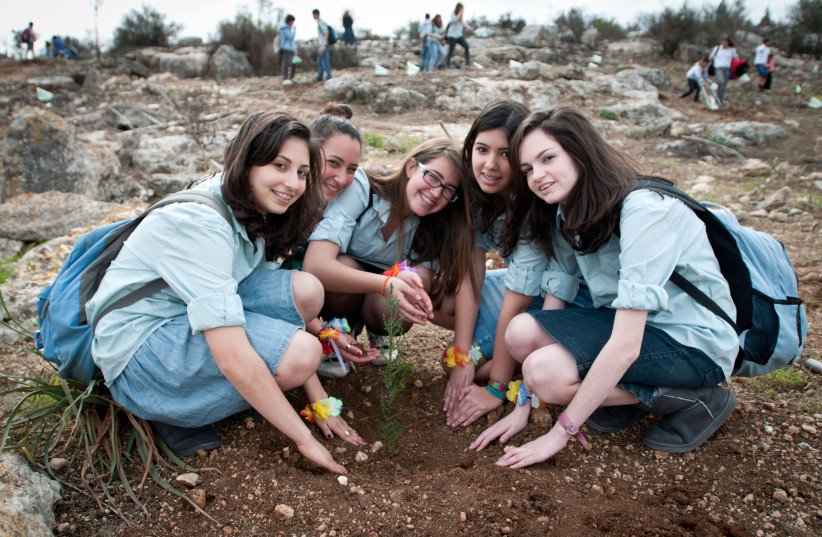Tu Bishvat, and a message of hope

It is surprising that Tu Bishvat, the celebration of a “New Year for the Trees,” falls in the middle of the winter.
With new COVID variants, seemingly never-ending vaccines, mandates causing tensions between government and citizens, and travel restrictions forcing the separation of families and friends this winter, there is a prevalent feeling of uncertainty.
The upcoming holiday of Tu Bishvat reminds us that despite it all, the Jewish people is always a nation with hope.
Tu Bishvat – the 15th day of the Jewish month of Shvat – is a unique holiday. According to the Talmud (Rosh Hashana 2a), Tu Bishvat was the day used to decide how old a tree was for tithing obligations. Fruit trees that blossomed before this date were considered part of the previous year’s produce; fruit trees that bloomed after Tu Bishvat were viewed as belonging to the following year’s crop.
Customs for this day, which include eating fruit, or in particular a “new fruit” over which one could recite shehecheyanu, arose over the centuries.
Yet, it is surprising that Tu Bishvat, the celebration of a “New Year for the Trees,” falls in the middle of the winter. In most regions, if one walks outside at this time of year and observes the trees, they look lifeless and dry. There is not a leaf to be seen. It would seem far more appropriate to celebrate Tu Bishvat in the spring, as the trees come to life with budding flowers.
The eminent 11th century French sage, Rashi explains (Rosh Hashanah 14) that even though the trees look lifeless, by Tu Bishvat, the sap begins to run within them. The sap – indicating the trees coming back to life and starting to nurture the future buds and fruit – usually starts to flow when the weather is still below freezing at night and starts to rise just above freezing during the day.
In Vermont or Quebec at this time of year, sugarmaker bore holes in maple trees to extract the sap. All that the trees will produce in the spring and summer is being prepared right now within the tree, in the dead of winter. The tree is coming back alive, although it is not yet visible.
Tu Bishvat teaches us to look beyond what we see on the surface, and know that hope can still spring eternal.
IN PARASHAT Beshalach, which coincides yearly within a week of Tu Bishvat, the Jewish people arrived in Marah, and could not drink the bitter water (Exodus 15:23). God responded to Moses by showing him a tree and directed him to throw it into the water, which miraculously transformed the water and made it sweet. Why did God use a tree?
We are told that to the Jewish people, the situation seemed hopeless. There were a few million people in the desert without water. The one source of water they found was undrinkable. The natural reaction was despair. What hope was there for the future?
At that point, God showed them a tree. When a situation looks hopeless and the future looks desolate and bleak, the tree symbolizes that the situation can turn around. Spring will happen! The dried out trees will come back to life. There can and will be a renaissance and renewal.
Throwing the tree into the water was a message to the Jewish people, then and always, not to give up. Not to worry about the desert, not to despair over the future. To know then and always that “the salvation of God comes in the blink of an eye.”
The verse in Deuteronomy 20:19 compares a human being to a tree, ki ha’adam etz hasadeh. Just as there are four seasons for a tree, there are seasons in a person’s life. There are periods in a person’s life when the future looks bleak, and things look miserable all around. What will be?The message of the trees, the message of Tu Bishvat, is to know that spring will come. The sap is running in the trees, and the (hopefully) abundant winter rains will serve a purpose. The flowers will blossom, the juicy fruits will grow, and the sun will shine again.
The late president Shimon Peres observed: “Sometimes people ask me, ‘What is the greatest achievement you have reached in your lifetime?’ I reply, ‘There was a great painter named Mordecai Ardon, who was asked which picture was the most beautiful he had ever painted. Ardon replied, ‘The picture I will paint tomorrow.’ That is also my answer.”So too, we need to know that the difficulties of our time will pass. The darkest part of the winter comes just before spring. Tu Bishvat teaches us that if we keep our faith in God and ourselves, our greatest days still lie ahead.The writer is CEO of the Joan Dachs Bais Yaakov – Yeshivas Tiferes Tzvi in Chicago. He served as rabbi of Congregation Am Echad in San Jose from 2007-2020. His website is https://thinktorah.org
Jerusalem Post Store
`; document.getElementById("linkPremium").innerHTML = cont; var divWithLink = document.getElementById("premium-link"); if (divWithLink !== null && divWithLink !== 'undefined') { divWithLink.style.border = "solid 1px #cb0f3e"; divWithLink.style.textAlign = "center"; divWithLink.style.marginBottom = "15px"; divWithLink.style.marginTop = "15px"; divWithLink.style.width = "100%"; divWithLink.style.backgroundColor = "#122952"; divWithLink.style.color = "#ffffff"; divWithLink.style.lineHeight = "1.5"; } } (function (v, i) { });

